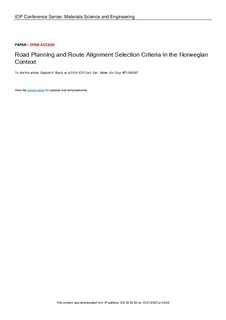| dc.contributor.author | Booto, Gaylord Kabongo | |
| dc.contributor.author | O'Born, Reyn Joseph | |
| dc.contributor.author | Ebrahimi, Babak | |
| dc.contributor.author | Vignisdottir, Hrefna Run | |
| dc.contributor.author | Brattebø, Helge | |
| dc.contributor.author | Pitera, Kelly | |
| dc.contributor.author | Wallbaum, Holger | |
| dc.contributor.author | Bohne, Rolf André | |
| dc.date.accessioned | 2020-01-23T08:43:01Z | |
| dc.date.available | 2020-01-23T08:43:01Z | |
| dc.date.created | 2019-03-05T10:57:01Z | |
| dc.date.issued | 2019 | |
| dc.identifier.citation | IOP Conference Series: Materials Science and Engineering. 2019, 471 (5), . | nb_NO |
| dc.identifier.issn | 1757-8981 | |
| dc.identifier.uri | http://hdl.handle.net/11250/2637570 | |
| dc.description.abstract | This paper reveals the main factors that guide road alignment design process in Norway. The goal is to discover what constitutes the main priorities for road planners, how these priorities are ranked when it comes to alignment selection, and how they are related to guiding factors identified in official planning documents and government transport plans throughout the life cycle of a road. This is done through a comprehensive literature and data search, involving published academic research in the road alignment design field, and by exploring Norwegian road planning documents and guidelines. Examples from a recently implemented road project are also included as a way to illustrate alignment priorities in theory versus how alignment decisions are made in practice. Particular attention is paid to how key factors influence environmental and social dimensions and how much importance these dimensions are given in the overall decision-making process. The focus on the Norwegian case is relevant in that it will identify which knowledge gaps need to be filled based on actual practices in the Norwegian road sector. The results of this study found that the dominating factors in road planning and alignment selection are the user cost and the environmental and socio-economic as they are directly related to the main national transport strategy of developing a carbon-neutral and resilient transport system. These results can be used to reinforce and amplify existing road planning strategies and to understand where challenges for environmental and social responsible road planning and alignment selection are found. | nb_NO |
| dc.language.iso | eng | nb_NO |
| dc.publisher | IOP Publishing | nb_NO |
| dc.rights | Navngivelse 4.0 Internasjonal | * |
| dc.rights.uri | http://creativecommons.org/licenses/by/4.0/deed.no | * |
| dc.title | Road Planning and Route Alignment Selection Criteria in the Norwegian Context | nb_NO |
| dc.type | Journal article | nb_NO |
| dc.type | Peer reviewed | nb_NO |
| dc.description.version | publishedVersion | nb_NO |
| dc.source.pagenumber | 10 | nb_NO |
| dc.source.volume | 471 | nb_NO |
| dc.source.journal | IOP Conference Series: Materials Science and Engineering | nb_NO |
| dc.source.issue | 5 | nb_NO |
| dc.identifier.doi | 10.1088/1757-899X/471/6/062007 | |
| dc.identifier.cristin | 1682312 | |
| dc.description.localcode | Content from this work may be used under the terms of theCreative Commons Attribution 3.0 licence. Any further distribution of this work must maintain attribution to the author(s) and the title of the work, journal citation and DOI. Published under licence by IOP Publishing Ltd | nb_NO |
| cristin.unitcode | 194,64,91,0 | |
| cristin.unitcode | 194,64,25,0 | |
| cristin.unitname | Institutt for bygg- og miljøteknikk | |
| cristin.unitname | Institutt for energi- og prosessteknikk | |
| cristin.ispublished | true | |
| cristin.fulltext | original | |
| cristin.qualitycode | 1 | |

